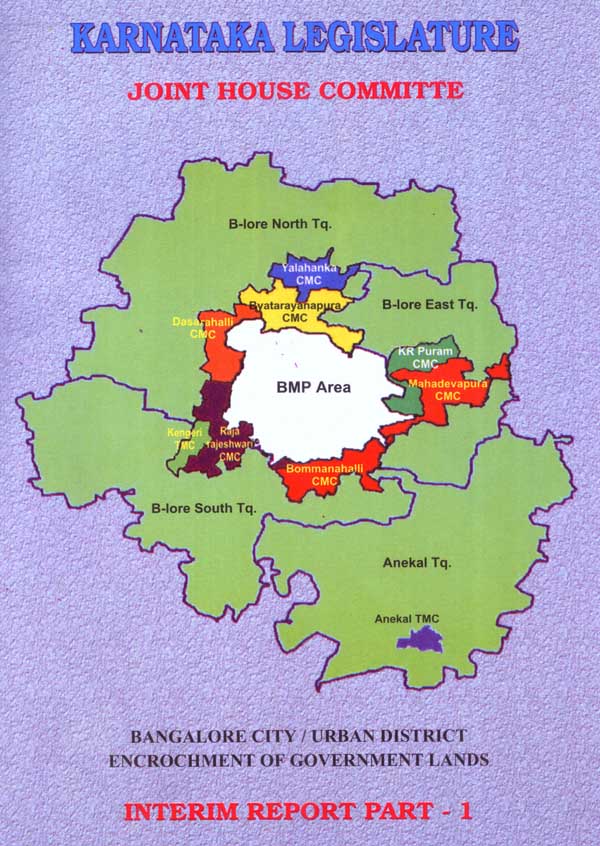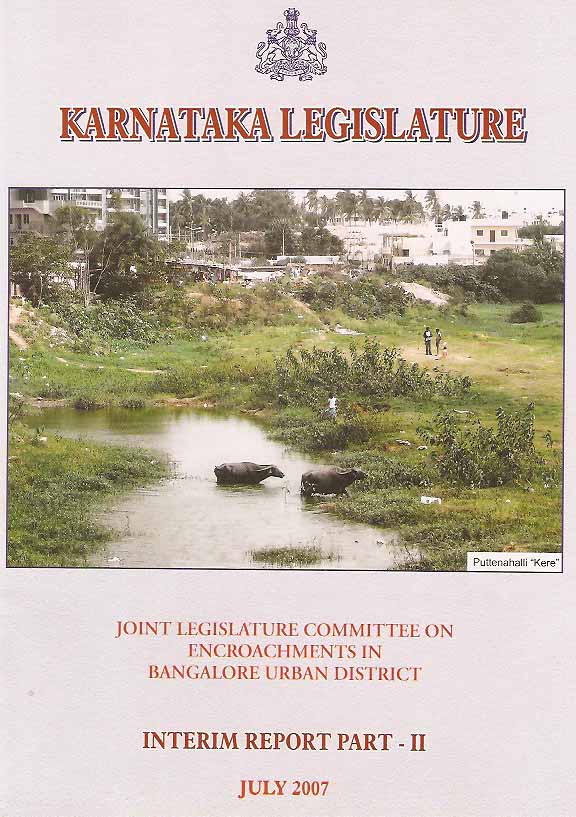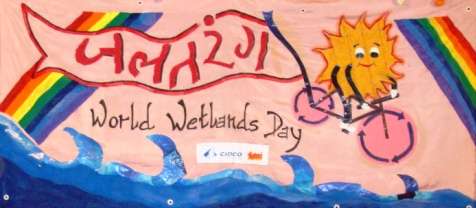Governance
Ramaswamy Joint Legislature Committee Report on the encroachment of lands in Bangalore Urban district (2006)
Posted on 21 Mar, 2010 04:45 AM The Joint Legislature Committee on Encroachments in Bangalore Urban District, was constituted in June 2006 with 14 MLAs and 6 MLCs, with A T Ramaswamy as Chairm
The Joint Legislature Committee on Encroachments in Bangalore Urban District, was constituted in June 2006 with 14 MLAs and 6 MLCs, with A T Ramaswamy as Chairm an. The attached report contains translated excerpts from the original Kannada report released in 2007, as well as a complete detailed version of the interim reports.
an. The attached report contains translated excerpts from the original Kannada report released in 2007, as well as a complete detailed version of the interim reports.
The report written on the basis of spot inspections, land surveys and hearings of various government departments and statutory bodies, concludes that the various state bodies such as the Bangalore Development Authority, Bruhat Bengaluru Mahanagara Palike, City and Town Municipal Councils etc, miserably failed in their duties to protect Government and public land, and have become helpess, tolerant witnesses, and in many cases, active participants, abettors and promoters in these crimes in tandem with the land mafia.
NREGA news updates collated by the Foundation for Ecological Security (16-31 Oct 2010)
Posted on 21 Mar, 2010 03:45 AMArticle and Image Courtesy: Foundation for Ecological Security (FES)
Barrages as a better alternative to Polavaram dam project
Posted on 20 Mar, 2010 06:34 PMBARRAGES AS A BETTER ALTERNATIVE TO POLAVARAM DAM POJECT
(Replies to Discussion Report of Advisory Committee on alternate proposals made for
Polavaram project by Sri.T.Hanumantha Rao, former Engineer-in-Chief, AP State)
Extent of social inclusion in the Government of Rajasthan's Integrated Fluorosis Mitigation Programme (RIFMP)
Posted on 20 Mar, 2010 04:36 AMThis paper presents and explores the efforts of the Government of Rajasthan, in tackling the problem of fluorosis and in ensuring that the Rajasthan Integrated Fluorosis Mitigation Programme (RIFMP) impacts all segments of the target population, including dalits.
Rajasthan has almost half of the total villages, with the highest levels of fluoride in the country. After the success of the UNICEF pilot project using Domestic De-fluoridation Units (DDUs) at household levels, the Government of Rajasthan in 2005 adopted this technology and implemented the Rajasthan Integrated Fluorosis Mitigation Programme (RIFMP), across the state.
Achieving drinking water security through participatory IWRM approaches in Dhasan sub-basin - A case study by WaterAid and Haritika
Posted on 20 Mar, 2010 04:05 AMThis presentation describes the work of WaterAid and Haritika in organising drinking water security through Integrated Water Resource Management (IWRM) approaches, in Dhasan river sub-basin (part of Bharar river basin), Nowgon block, Chattarpur district of Madhya Pradesh.
Environmental issues, law and technology An Indian perspective
Posted on 19 Mar, 2010 02:15 PMDue to emphasis on Environmental Education, the subject is being taught at all levels of education. It is indeed pleasure to see technology students of all branches are being taught with the subject in first year. The Environmental issues and law varies from country to country and is unique to India. Understanding the issues does need lot of research and study ma
Action plan workshop for the rejuvenation and sustenance of the Arkavathi river basin - Discussion summary and research papers (2009)
Posted on 12 Mar, 2010 04:14 AMA one-day “Action plan workshop for the rejuvenation and sustenance of Arkavathi river basin”, was organised on 25th July 2009, by the Global Academy of Technology and Geological Society of India at Bangalore, to discuss the future of the dying Arkavathi river and Bangalore's precarious water situation, and to develop concurrent implementable action plans to address the problem. The Arkavathi is a tributary of the river Kaveri, originating in Nandi Hills in Chikkaballapur district, that provides about 20% of the total water requirements of Bangalore, with Kaveri providing the remaining 80%.
Jaltarang, a celebration of World Wetlands Day - An update from TERI's wetland management program in Navi Mumbai
Posted on 11 Mar, 2010 10:45 PM The satellite township of Navi Mumbai, with a total area of 344 km2, was developed in 1972 by CIDCO (City and Industrial Development Corporation) to de-congest the city of Mumbai. Initially a marshy land interspersed with villages, Navi Mumbai has been developed into a planned township, with much of its marshes and freshwater wetlands being converted into urban infrastructure.
The satellite township of Navi Mumbai, with a total area of 344 km2, was developed in 1972 by CIDCO (City and Industrial Development Corporation) to de-congest the city of Mumbai. Initially a marshy land interspersed with villages, Navi Mumbai has been developed into a planned township, with much of its marshes and freshwater wetlands being converted into urban infrastructure.
Navi Mumbai is a rapidly developing twin city. In the course of development, it was realized that more emphasis needs to be given towards the preservation and sustainable management of the freshwater wetlands it harbours. Given the vulnerability of these wetlands and their resource potential, there is an urgent need to develop a framework for sustainable use of freshwater wetlands. This requires efficient management systems and development of sustainable models, which would help maintain the natural characteristics of wetlands while also exploiting its potential to meet the socio-economic and recreational needs of communities. To tackle this important aspect, TERI conceptualized a pilot project with active support of CIDCO in October 2008. The Khandeshwar Lake was chosen as a model to demonstrate the feasibility as a ‘sustainable wetland’.
The attached presentation is an update on the work taken up and impact achieved since the start of the project, and includes details from the World Wetlands Day celebration organised on 2 February 2010. Details of TERI's wetland management program are here.
State Government of Bihar is inviting comments from the public, on the Bihar State Water Policy Draft (2009)
Posted on 11 Mar, 2010 05:06 AMIn the context of the guidelines of the revised National Water Policy (2002) which require the states to prepare a comprehensive state-level water policy, and also the need to pay special attention towards the construction of new irrigation projects, along with water management, land management, food management, floods management, ecological balance etc, in the context of the various new developments and problems being faced by the state of Bihar over the last decade or so, the Water Resources Department of the State Government of Bihar has prepared a draft State Water Policy (2009) and is inviting comments from the general public.
The Vand women of Kachchh - A case study on drinking water management from the work of Samerth Trust in Kutch, Gujarat
Posted on 07 Mar, 2010 02:23 AMThis case study is about Samerth's efforts to achieve drinking water security, in participation with local village communities in Rapar, Kachchh (Gujarat). Arghyam has been collaborating with Samerth on this effort since 2007.
The Vand Women of Kachchh: Guest post by Keya Acharya
She gazes unflinchingly with direct eyes into the camera with a feminine mystique and physique that could, be gracing the front cover of a beauty magazine. Her red, mirror-worked blouse, in the traditional Kachchhi style worn by tribal women, is strapped at the back in stringed bows, greatly practical in the dry, wilting heat of that arid expanse of land in hinterland Gujarat called Kachchh. Her skirt is a colourful hue of printed green, and her ‘dupatta’ is a blazing red piece of cloth swept forward from her waist, partially covering her back, brought over her head and tucked back demurely into her waist again. Her name is Ammi.





